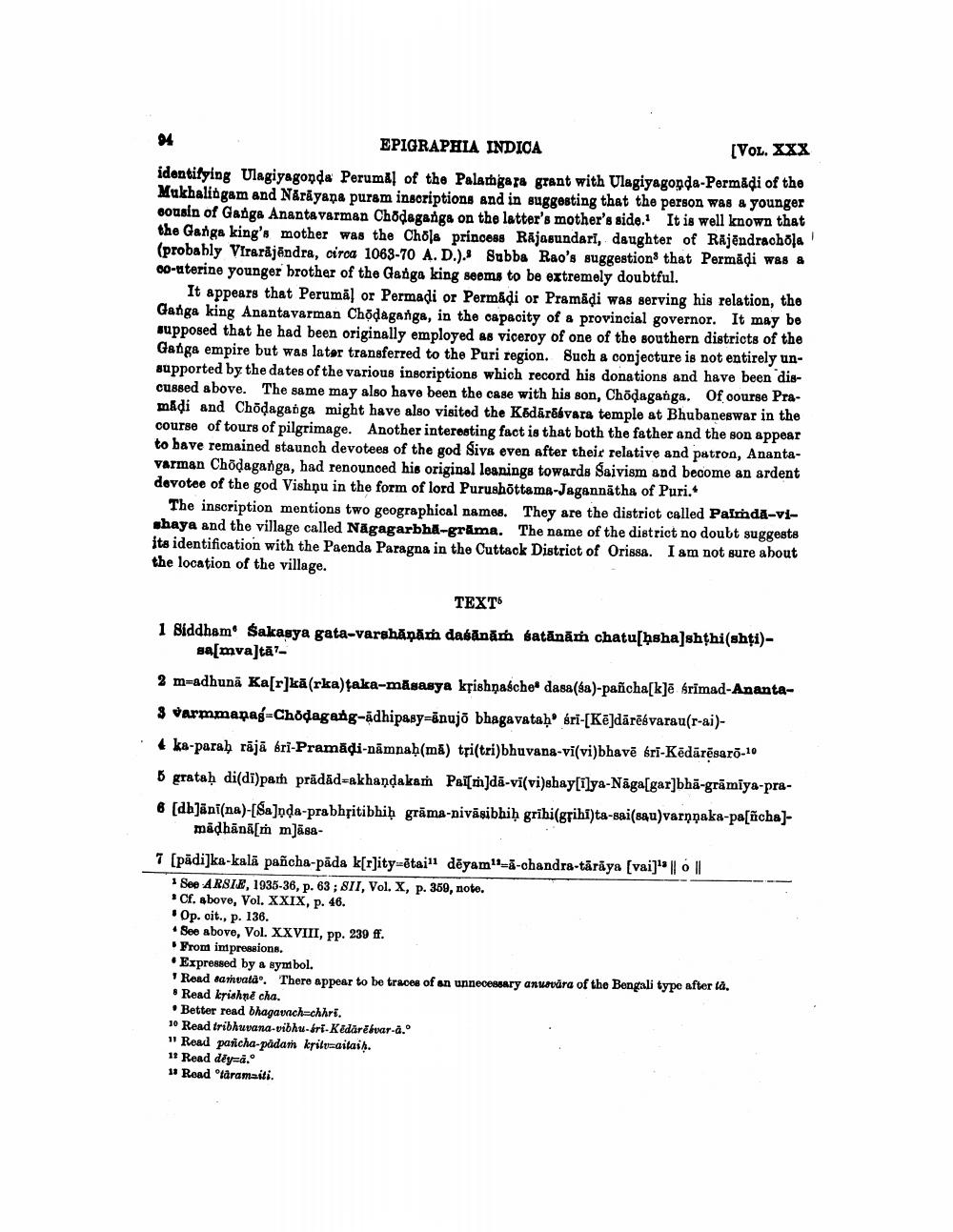________________
EPIGRAPHIA INDICA
[VOL. XXX
identifying Ulagiyagonda Perumal of the Palathgara grant with Ulagiyagonda-Permadi of the Mukhalingam and Narayana puram inscriptions and in suggesting that the person was a younger cousin of Ganga Anantavarman Chodaganga on the latter's mother's side. It is well known that the Ganga king's mother was the Chola princess Rajasundari, daughter of Rajendrachola (probably Virarājēndra, circa 1063-70 A.D.). Subba Rao's suggestions that Permädi was a 00-uterine younger brother of the Ganga king seems to be extremely doubtful.
It appears that Perumal or Permadi or Permadi or Pramādi was serving his relation, the Ganga king Anantavarman Chodaganga, in the capacity of a provincial governor. It may be supposed that he had been originally employed as viceroy of one of the southern districts of the Ganga empire but was later transferred to the Puri region. Such a conjecture is not entirely unsupported by the dates of the various inscriptions which record his donations and have been discussed above. The same may also have been the case with his son, Chodaganga. Of course Pramádi and Chodaganga might have also visited the Kódārēbvara temple at Bhubaneswar in the course of tours of pilgrimage. Another interesting fact is that both the father and the son appear to bave remained staunch devotees of the god siva even after their relative and patron, Anantavarman Chodaganga, had renounced his original leanings towards Saivism and become an ardent devotee of the god Vishnu in the form of lord Purushottama-Jagannātha of Puri."
The inscription mentions two geographical names. They are the district called Palmda-vishaya and the village called Nāgagarbha-grāma. The name of the district no doubt suggests its identification with the Paenda Paragna in the Cuttack District of Orissa. I am not sure about the location of the village.
TEXTS 1 Siddham Sakasya gata-varshāņām dasānăm satānāṁ chatu[hsha]shthi(shți)
sa[mva]tā?2 m-adhuni Ka[r]kā (rka)taka-misasya krishņaschet dasa(sa)-pañcha[k]ē Srimad-Ananta3 varmmapag=Chodagang-adhipasy-anujo bhagavataḥ śri-[Kējdārēsvarau(r-ai)4 ka-parah rājā bri-Pramāļi-nämnaḥ(mā) tri(tri)bhuvana-vi(vi)bhavē bri-Kēdārēsaro-10 B grataḥ di(di)par prādād=akhandakam Pal[m]dā-vi(vi)shaylilya-Nāga[gar]bhā-grāmiya-pra6 [db]äni(na)-[Sa]oda-prabhsitibhiḥ grāma-nivāsibhiḥ grīhi(grihi)ta-sai(sau)varnnaka-pa[ñcha)
madhānām m]āsa7 (pādi]ka-kalā pañcha-pāda k[r]ity=ētai"1 dēyam"-ā-chandra-tārāya (vai]|| 6 ||
See ARSIE, 1935-36, p. 63; 8I1, Vol. X, p. 359, note. *Cf. above, Vol. XXIX, p. 46. "Op. cit., p. 136. * See above, Vol. XXVIII, pp. 239 ff.
From impressions. • Expressed by a symbol. * Road samvata. There appear to be traces of an unnecessary anumara of the Bengali type after ta. . Read krishné cha. • Better read bhagaunch-chiri. 10 Read tribhuvana-vibhu-sri-Kedārēbvar-a. 11 Read pancha-padam kril-aitaih. 12 Read dēv=a. 11 Read taramaiti.




